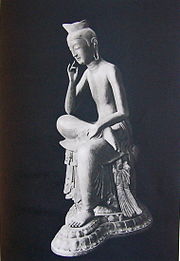| No Title | |
|---|---|
[[ |250px]] |250px]] | |
|
No Title |
No information |
The Bangasayusang, or Geumdong Mireuk Bosal Bangasayusang (literally Gilt-Bronze Maitreya Bodhisattva Half-sitting Thinking Statue), is a gilt-bronze statue of what is believed to be the Maitreya, the future Buddha, in a semi-seated contemplative pose. It is commonly referred to as the Contemplative Bodhisattva or Gilt-Bronze Seated Maitreya in English. It is the National Treasure of Korea No. 83,
The Bangasayusang is widely acknowledged to be one of the finest Buddhist sculptures ever produced and is a masterpiece of Korean art. It is now housed at the National Museum of Korea and is one of the most popular exhibits there.
Origins[]
The statue is believed to have been made in the early 7th century. Recent scholarship consensus indicates that the statue is probably from Silla because of drapery fold studies although some believe that this was a Baekje piece. It is 93.5 centimeters tall or approximately 3 feet and one inch in height, and is therefore incredibly valuable because few large bronzes survived from that period. It is made of bronze, and was at one point plated in gold.
Description[]

A side profile of the sculpture
The Bangasayusang is seated on a round pedestal and posed with its right leg of the crossed over its left knee while the figure's right hand is touching its cheek and the left hand rests on the crossed leg. This contemplative pose was a popular subject of Buddhist art and the archetype spread from India to China and Korea and then to Japan. Other common similarities of the Maitreya statues of this style is the use of drapery on the seat on which the figure sits. Chinese depictions of the drapery that the Maitreya sits on are highly stylized, stiff, and formalized. However, the artists' depiction of the drapery on the Bangasayusang is flowing and realistic which gives the statue an illusion of animation. The slender, almost lithe body of the figure suggests Baekje influences. However, the bridgeline and sharp nose of the figure suggests a Silla provenance. Although the actual provenance of the statue is still unknown, the current art historian consensus is that the statue is from a Sillan caster because of the Silla-style of the drapery depicted over the pedestal.
The figure is perfectly proportional and the sensuality of the draping both suggests that the sculptor based this work on a real model. Other figures of the Maitreya-type are often distorted or stylized to fit the artistic tradition the sculptor was working from. The harmony between the lower half and upper half of the statue is example of the attention to detail and realistic proportionality. The figure has a tri-fold crown on its head which is very simple, unlike other works of this genre which have highly elaborate headdresses. The halo of the figure has long since been lost although a part of the halo remains attached to the figure. The Bangasayusang is also bare-chested which adds to the simplicity of the figure. The figure gives a sense of calm meditation but still conveys a sense of moving dynamism because of its posture and the artistic styling of the bronze.
Similar works[]

Miroku bosatsu at the Koryu-ji Temple of Kyoto
The Miroku bosatsu at the Koryu-ji Temple of Kyoto, which is the first Japanese National Treasure, is the twin of the Bangasayusang and is almost certainly of Korean origin. [1] The Miroku is carved from red pine and may be the statue the Nihon Shoki mentions that a King of Silla sent to the Yamato court. The statues both share the elegant contemplative pose, highly proportional figures, realistic draperies, slim bodies, and plain tri-fold crowns.
The Bangasayusang is often compared to Auguste Rodin's work, The Thinker because of its contemplative pose.
National Treasure No.83, although priceless, is insured for an estimated 50 billion won and is the most expensive national treasure of Korea. [2]
Footnotes[]
| Wikimedia Commons has media related to: Bangasayusang |
See also[]
- National treasures of Korea
- Geumdong Mireuk Bosal Bangasang
External links[]
ko:반가사유상 ja:弥勒菩薩半跏思惟像